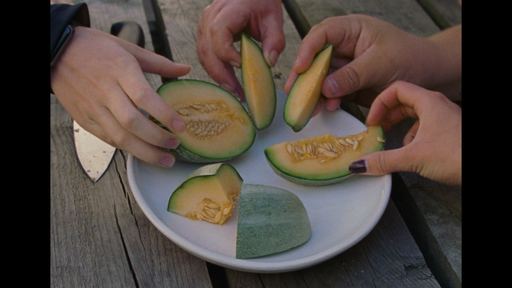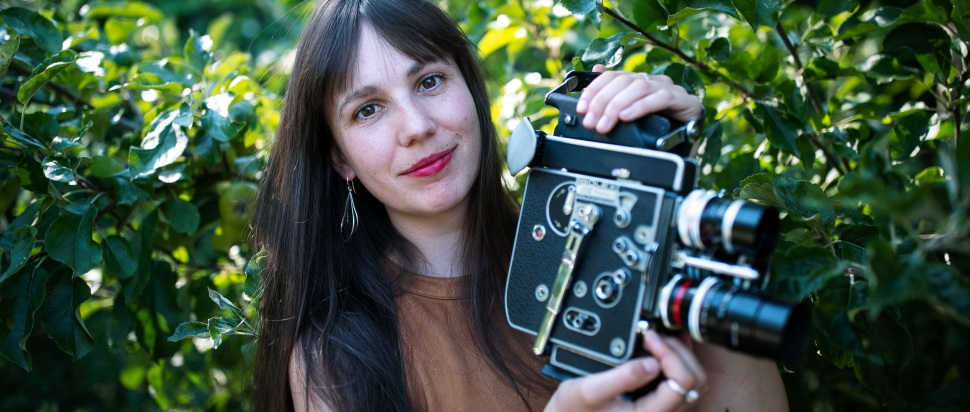Julia Parks on her Alchemy residency in Hawick
Julia Parks is the most recent artist to take part in Alchemy Film & Arts' The Teviot, the Flag and the Rich, Rich Soil residency – she enjoyed it so much she's moved to Hawick permanently
Film festivals can sometimes feel airdropped into their surroundings. No such charge could be laid at the feet of Alchemy Film and Moving Image Festival. Since 2010, it has been hosting a celebration of experimental film in Hawick, and with every edition, it feels more integrated with its community. As well as the festival, which has become a favourite for UK and international experimental filmmakers, Alchemy concerns itself with year-round community projects that have turned this small town in the Scottish Borders into a creative hub.
One such project is The Teviot, the Flag and the Rich, Rich Soil, a programme of artist residencies concerned with creating work about Hawick and the wider region. West Cumbrian artist Julia Parks is the latest to complete this residency, and it's fair to say it went well. After six months of filming in the town, Parks moved there permanently.
“It's great, Hawick,” Parks beams when she speaks to us on Zoom “It’s got such a nice sense of community and we've got loads of friends here. I've never lived somewhere like that before, so I guess that's an interesting outcome from the project.”
When we speak to Parks, she’s applying finishing touches to the four films she made during the residency, which will have their world premiere at Alchemy this month. The longest and richest is The Wool Aliens, a poetic documentary exploring the 'alien' flora that has flourished on riverbanks throughout the Borders.
The idea sprang from a conversation with Rachael Disbury, Alchemy’s co-director. “Rachel mentioned this story of [non-native] seeds moving down the rivers in the Borders thanks to the washing of imported wool, but she wasn't sure whether it was true,” recalls Park. “I've always been interested in that relationship between industry and nature, so that these foreign seeds were coming in from the wool mills just felt too good to be true.”
The film blends archive, interviews and Parks’ evocative 16mm film footage. We learn about Ida Hayward, the woman who, in the early 20th century, was among the first to identify the strange new species that had cropped up on the banks of the River Tweed and the Gala Water. In the modern-day, a man in a hazmat suit chops down 15ft stalks of Giant Hogweed and a woman gathers up armfuls of the pervasive Pirri Pirri plant. But the film goes to lengths to demonstrate these 'wool aliens' have their uses, such as dyes or medicinal purposes.

Burnfoot Grows
“I guess I wanted to add a different perspective to the idea of these plants being problematic,” says Parks. “Obviously I filmed people who are trying to get rid of them, but there was also Luke, the botanist, who had a slightly different idea, telling me that over 50 per cent of the plants in Britain have been imported from elsewhere, and likewise, loads of our plants have been exported across the world.” You don’t have to look too hard to see a compelling analogy to the history of immigration in this country.
Parks’ second film, Tell Me About the Burryman, takes her to South Queensferry during the leadup to the Burryman's Parade, a centuries-old custom in which a local man is covered from head to foot in greenish burrs (described as “nature’s velcro”) and then paraded through town. It’s a spectacle that’s part Midsommar, part The Last of Us. “Originally I thought that this would be part of Wool Aliens because the Burryman looks like an alien,” she says. “But it ended up being such a lovely thing in its own right that it had to stand alone.”
All Flesh is Grass is the most expressionistic, and darkest, of the quartet. It takes the form of a series of scenes juxtaposing nature and industry, life and death. “This was all filmed to the backdrop of insanely hot weather and a serious drought in the Borders,” Parks explains. “On the radio, there were stories of sewage leaks into the Tweed, there were fires and there was so much roadkill on the roads. And in Hawick, flood defences were being built, these massive structures to protect the town from flooding. I think that just made me reflect on the interrelationship between people and animals, and the natural environment.”
These three films have an otherworldly quality, tapping into themes of migration, pagan ritual and climate crisis. The final work, Burnfoot Grows, filmed at Burnfoot Hub, a community centre and garden in Hawick, is a much more grounded celebration of community, made in collaboration with that community.
“I wasn't like, 'Right I'm coming here to film this and this and this,'” says Parks. “Joyce [Short, the Hub’s supervisor] would say, ‘All this is happening this week, do you want to film it? You can if you want, no pressure.’ So it was made with the people who work in the garden and a couple of the younger volunteers, Dion and Brandon, helped with the sound and to get some of the shots. So it was much more organic, very collaborative.”
Each film, shot on 16mm, is a beautiful piece of work in its own right, but taken together they’re a fascinating document of the culture and mores of this particular part of the world. Credit to Alchemy for not only programming some of the best experimental films in the UK, but also helping them get made.
Alchemy Film and Moving Image Festival, Hawick, various venues, 27-30 Apr; Parks' four films premiere on 29 Apr, Heart of Hawick, 7.30pm
Filmography (selected): Seaweed (2022), DESIG /DESIRE (2022), HAAF (2020), Workington Red (2020), Solway Steel and Cyclamen (2019), The Girl Who Forgets How to Walk (2019), Tommy Armstrong: the pitman poet (2018), Oslo Havn (2018), Solway Film (2016), Glimpse from the Garden (2014), Journey Film (2014), Jackfruit (2012)
w: juliaparks.co.uk
